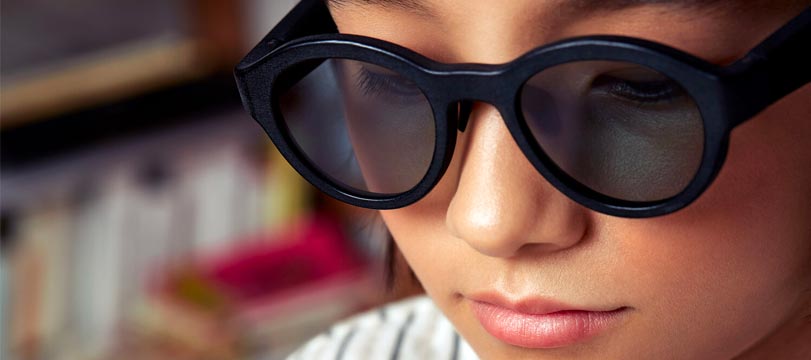
06:39 -
@Atol
Affecting around 8% of people worldwide, dyslexia (specific reading disability) is the most common of cognitive disorders and affects 80% of all those identified as having learning difficulties. Harnessing a recent scientific discovery, Atol’s Lexilens smart eyewear aims to make reading and learning easier for people with dyslexia. Here we look at the journey from scientific discovery to product innovation.
Recognized by the World Health Organization in 1991 as developmental learning disorders and written into the French law of February 11, 2005 as cognitive disorders, specific language and learning disorders are grouped under the term DYS disorders. “DYS” because they share the same Greek prefix, meaning “difficult, disordered”: dyslexia, dyspraxia, dysphasia and certain consecutive manifestations of these disorders, like dysorthography, dysgraphia and dyscalculia. These disorders are termed ‘specific’, as the children affected do not initially have any intellectual disabilities, nor any notable psychiatric or psychological disorders.
Documented for the first time in 1896 in the British Medical Journal, dyslexia is a “specific and significant reading impairment”, according to the French Federation of DYS Difficulties. Showing up when starting to read, dyslexia is characterized by difficulty in mastering the alphabetical phase, the point where the child establishes links between a sound (phoneme) and a letter or a group of letters (grapheme). Naturally, this makes it difficult for the child to decode words at a sustained pace and spell them. Incidentally, we associate dyslexia with dysorthography almost systematically. The effects of this cognitive disability can be numerous in terms of issues with memorization, acquiring the automatisms of written language and expression, coordination, analysis, etc. Efforts made by the dyslexic to try to compensate for their difficulties also affects their fatigability and attention.
According to Inserm (the French National Institute of Health and Medical Research), this enduring disorder faced by around 8% of people worldwide affects three times as many boys as it does girls and is more common in left-handed people. An estimated 74% of second grade children with reading problems continue to find it difficult in third grade as well. Among the other long-term impacts of dyslexia, an estimated 40% to 60% of individuals with DYS disorders experience psychological disorders such as anxiety, depression and ADHD.
Among the DYS disorders, dyslexia is by far the most prolific scientific research topic. Long associated with psychological and/or emotional factors, the reasons behind this disorder seemed to be moving for several years towards other avenues, the neurological avenue in particular. This was the one that was followed for nearly 15 years by Albert Le Floch and Guy Ropars, laser physics researchers at the Université de Rennes. The results of their work were published in October 2017 in The Royal Society’s science journal and won the Raymonde Destreicher prize at the end of 2020, an award from the French Academy of Medicine, which highlights work relating to eye medicine.
First of all, the two physicists wondered if light could play a role in reading and learning disorders. Their work gradually led them to focus on a possible link between the functioning of the eyes, the brain and certain types of dyslexia. Their research then encouraged them to study tiny light receptors called Maxwell spot centroids, named for the great 19th century British physicist. These receptors are located in an area of the retina no bigger than one square millimeter, known as the fovea, where the vision is sharpest. Half of the fibers that connect the eye to the brain are concentrated in this area.
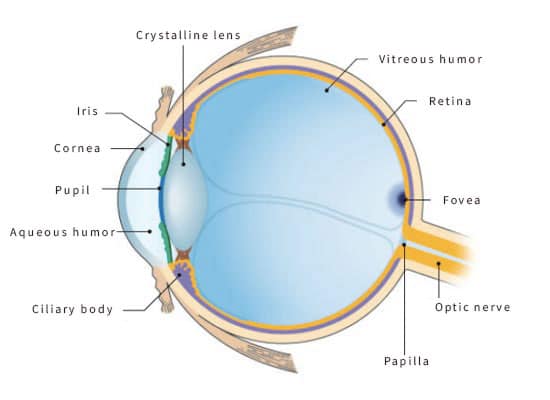
@sciencesetavenir.fr
By examining the centroids, the Rennes-based researchers discovered that their shape was different in dyslexics and might partly explain the reading disorder. Accordingly, in someone not suffering any disorders, the shape of the Maxwell spot differs from one eye to another; while one spot is round, the other has an imprecise, sort of “potato” shape to use Albert Le Floch’s own words. The eye that is round in shape is referred to as primary or dominant. When someone without dyslexia is confronted with the letter “b” for example, the dominant eye sees the “b” and the other eye sees its mirror image, which is “d” (the same goes for the letter “p”, which turns into “q”), but the dominant eye eliminates the mirror image and allows the correct signal to be sent to the brain.

@indesciences.com
In dyslexics, the receptors are identical in shape and therefore they do not have a dominant eye. It is this symmetry that could cause confusion in the brain, for lack of dominance of one eye over another; the brain cannot choose. Here, the “b” and its mirror image “d” become confused. Noting the delivery time to the brain as being around 10 milliseconds between the primary image and the mirror image, the two researchers then developed an LED strobe light, using a certain frequency and intensity to erase the mirror image. The light effectively created a fictitious dominant eye by fooling the brain.
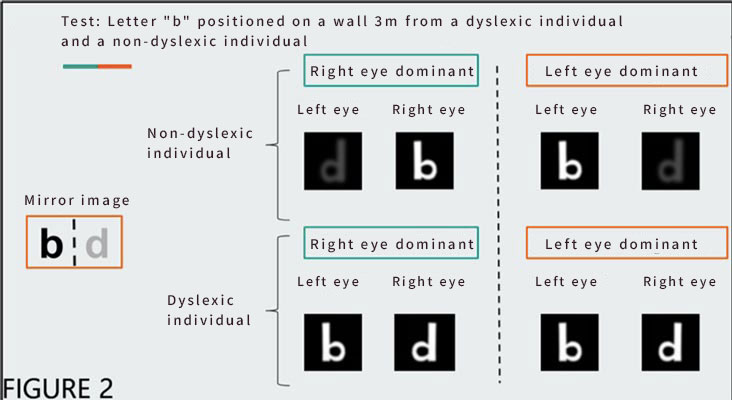
@indesciences.com
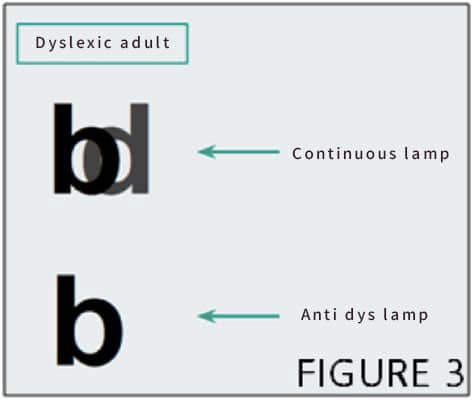
@indesciences.com
Michael Kodochian, the founder of the Burgundy-based startup Abeye incubated by Atol, took an interest in the work of Albert Le Floch and Guy Ropars and set himself the goal of developing eyewear based on the concept behind the “anti dys” lamp developed by the two physicists in Brittany. Already behind Atol Zen, the smart eyewear that can detect falls and automatically alert friends and family or the emergency services (like the Serenity by Ellcie Healthy), Abeye specializes in designing innovative smart eyewear for health and well-being. Based in Beaune, the startup launched in 2018 and is part of the Transform’Atol 2016-2020 program, a strategic plan that integrates several investment programs in the research and development of innovative products combining MedTech and the Internet of Things.
Based on the same concept as the lamp designed by the two Rennes-based researchers, the active filters embedded in the lenses and controlled by electronics embedded in the arms of the Lexilens (originally known as Atol Dys) therefore work to take away the mirror image. The device is activated at the push of a single button. Set-up using the dedicated smartphone app (iOS or Android) is required on first use, but takes less than 10 minutes. Filter settings, flicker rate, lens transparency… all the custom settings for the user’s physiology are then stored in the arms. As a class 1 medical device, Lexilens also offers the option to clip on corrective lenses.
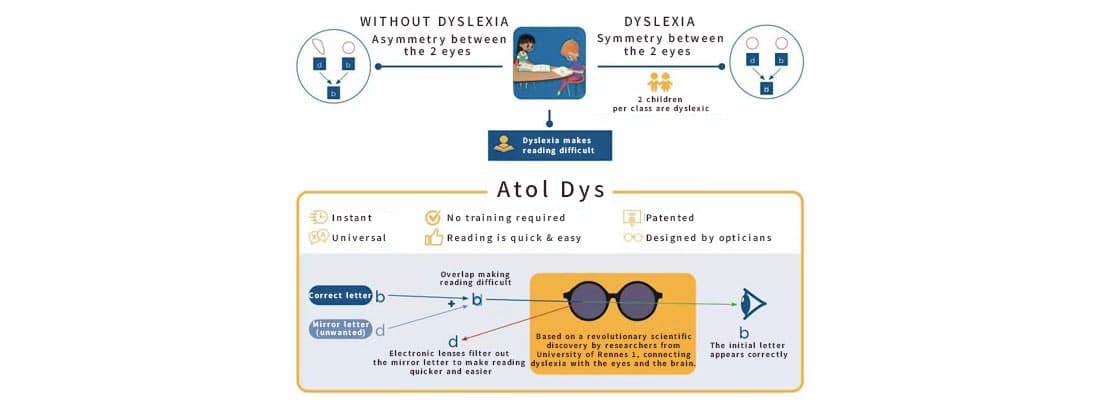
© Atol
As for the design of the Atol Zen, Abeye has set itself the target of producing a design that incorporates unobtrusive electronic components in glasses that look as ordinary as possible for the child wearing them. Made in France, the electronic part is produced in Haute-Garonne and the frames in the Paris area. The 35g frames are entirely 3D printed, in partnership with French specialist Erpro, using technology developed by HP. “Producing the 3D printed Lexilens glasses is unusual as the first multi-component product to be printed with such complexity of assembly. There are no less than nine components!”, said Nicolas Aubert, head of 3D printing for HP France. The frames are currently available in one colorway and one style, although more options are in the works.

Winner of a CES Innovation Award in 2020, an LSA Innovation Trophy in 2020 and a Silmo Gold award, Atol glasses seem to offer initial encouraging results. In laboratory tests, the Lexilens worked on 90% of people and when tested in store, the rate was 75% according to figures provided by Abeye. Éric Plat, CEO of Atol, also told Le Télégramme: “My 17 year old daughter is dyslexic. I know the effort she had to go to, through speech therapy and workaround strategies. With these glasses, she has gone from reading 60 to 100 words per minute“.
However, we’ll have to wait for the final results of the double-blind clinical study, the results of which should be available in the coming months. As well as being able to validate and scientifically confirm the results obtained so far, “ultimately, the aim of the clinical trial is to seek support from the authorities as well. The challenge is truly to do something useful”, said Michael Kodochian. You can try out Lexilens at Atol opticians by appointment. Currently priced at €399 euros, an adult version has also recently become available for €449 euros.
Written by Eleanor Fullalove